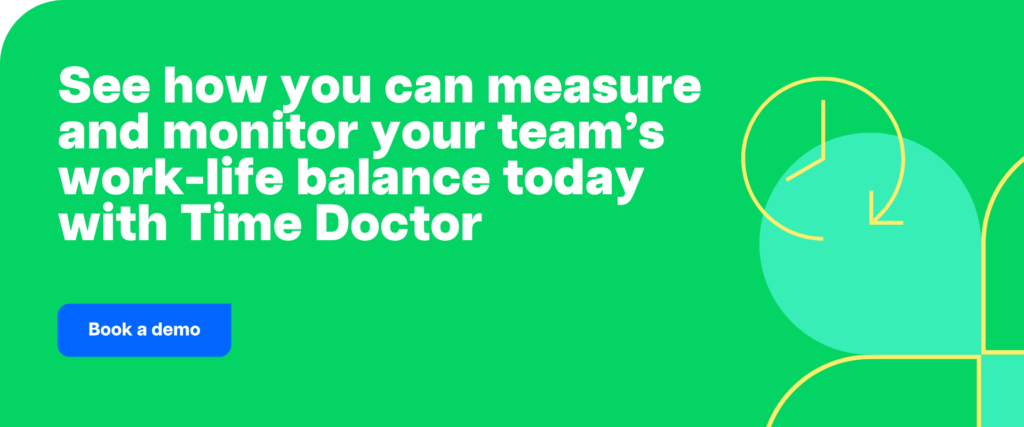We’re now several years from the start of the COVID-19 pandemic, but remote and hybrid working models are seemingly here to stay. Many companies favor these flexible work models thanks to their wide range of benefits, including lower attrition, more engaged employees, and lower operating costs.
But while remote work offers employees greater flexibility and control, it also presents unique work-life balance challenges as the line between work and personal life blurs. Fortunately, this can be mitigated if both employees and employers follow a few key strategies to help remote workers improve the efficiency and quality of their output and segregate their time better.
This article explores the significance of a healthy work-life balance among remote workers and the challenges they face despite the benefits of flexible work models. We’ll also examine the tips and strategies that remote workers and their employers can use to facilitate a healthy work-life balance and foster a productive and stress-free work environment.

The rise of remote work
Since remote work was forced quite unexpectedly on us during the pandemic, many companies have decided to stick with it. Although the number of fully remote workers has steadily decreased since the pandemic ended, remote and hybrid working models are becoming the new norm. 40.9% of full-time employees work either remotely or in a hybrid environment as of 2023.
It’s no coincidence that both employees and employers favor remote work models. There are plenty of benefits that validate these flexible working environments, including reduced commuting time, greater control over working hours, and reduced overhead costs. Employees typically relish the flexibility and trust that comes with working from home, as evidenced by the fact that 63% of employees preferred a more flexible work model in the wake of the pandemic.
However, remote work also has its downsides. Issues regarding isolation, communication, and productivity are frequent concerns of remote team members and employers. The following section highlights the challenges of remote work in more detail.
Challenges of work-life balance in remote work
Despite the apparent benefits that remote work brings, there are also challenges that remote and hybrid workers must overcome to ensure they work effectively and efficiently. These often include issues surrounding well-being, communication, isolation, and productivity.
Let’s look at some of the issues that remote workers have reported. Many typically find that the quality of internal communications decreases the longer they work at home. In a Federal Reserve Bank of New York survey, remote workers complained about the difficulty of short video consultations with their coworkers. When they needed to verify something or get support, they were often left waiting, which reduced their work efficiency.
Additionally, remote workers frequently complain of feelings of isolation. Working from home can be fun, but it can also get quite lonely, particularly if you live alone and have few acquaintances nearby. Feeling isolated can lead to more severe mental health problems, like stress, anxiety, and depression. This, in turn, can lead to reduced productivity at work. Some BPOs used to report considerable productivity problems among their remote staff until they got on top of the problem.
The main challenge that remote workers face, however, is maintaining a healthy work-life balance. Many of us already found this difficult before the pandemic when almost everyone worked from the office. Late nights, overtime and deadline sprints might be the norm in many industries, but it doesn’t mean they always have to be. If work is intruding on personal and family time, it can eventually cause burnout, lack of motivation, and even depression. Achieving a work-life balance is in the best interests of both employees and employers.
It’s true to say that maintaining a healthy work-life balance is often more challenging in fully remote or hybrid environments. Many employees struggle to sustain their physical and mental health, frequently neglecting to leave the house, exercise, and socialize. Moreover, a lack of separation between work and leisure spaces leaves remote workers with difficulties disconnecting from their jobs.
Employee well-being is critical to ensuring a positive workplace culture and maintaining high-quality output, so employers must give their staff adequate support. The following sections of this blog highlight tips and strategies that employees and employers can use to facilitate a healthy work-life balance for remote workers.
Tips for employees to achieve a work-life balance
Remote employees must take care of themselves to ensure optimum productivity, efficiency, and quality in their work. There are several strategies remote team members can use to maximize their output, boost their mental health, and mitigate any feelings of isolation:
- Establish a routine: First and foremost, you must establish a clear routine during your workdays. Setting yourself regular working hours and break times will help you get organized and feel less stressed. Taking small but regular breaks between tasks, or ten minutes every hour, will help you stick to your routine and work more productively.
- Set clear boundaries: This tip is multifaceted, as it involves setting boundaries in your home and with your work. Establishing designated work and rest areas in your house will help you stick to a routine and feel less overwhelmed by your tasks. Also, not taking on too much overtime or extra work from your job will help you achieve a healthier work-life balance.
- Make time for hobbies: Hobbies and after-work activities are a great way to de-stress after a long working day. They’re not only a good way to exercise but also an excellent excuse to socialize with others. This will bring massive benefits to both your physical and mental health.
- Prioritize mental health: Make time for mindful practices like meditation, yoga, and journaling. This will enhance your overall mental well-being, making you better prepared and more productive.

Tips for employers to support employee work-life balance
While remote workers must look after themselves, employers have a duty of care towards their employees when it comes to understanding and facilitating a healthy work-life balance. Companies can implement positive policies to reduce burnout, provide adequate resources and support, and invest in non-invasive tracking tools.
- Introduce company initiatives: To combat diminishing work-life balances among remote workers, employers must implement certain policies and initiatives. Introducing no-meetings days, respecting team members’ non-working hours, and rewarding healthy work-life balance practices are all proven strategies for fostering a productive and non-toxic working environment in distributed teams.
- Provide adequate resources: Companies must provide remote employees with the right resources, support, and training to achieve a healthy work-life balance. This may involve supplying communication tools, offering mental health resources, and providing regular check-ins and catch-up sessions.
- Invest in employee monitoring software: By introducing tools like Time Doctor into their distributed workforce, companies can accurately monitor their employees’ work-life balances and provide the proper support before their staff gets overwhelmed. The Work-Life Balance widget has helped numerous employers, like Geoff Ainsworth, VP of Engineering, reduce burnout and absenteeism and improve productivity.
Using Time Doctor’s work-life balance widget

Time Doctor’s Work-life Balance widget can be accessed on your Team Dashboard. It allows administrators and managers to quickly identify employees at the highest risk of burnout due to a poor work-life balance.
Employees that show up on the Work-life Balance widget after having at least 5 potential work-life balance issues in a 30-day time period. The new widget displays the number of issues, plus details on what types of problems have been found, on the new widget.
The type of work-life balance issues that get flagged up include when employees:
- Work too many late hours
- Work too many hours per day
- Work on the weekends
- Work too many hours outside of scheduled shifts
Time Doctor administrators are 100% in control of the work-life balance metrics. They can set these metrics to raise a flag on the basis of what their company considers too much. For example, in the example below, the admin has decided that working after 8pm or on the weekend could be a cause for concern in terms of work-life balance.
Once a flag is raised, supervisors can check what the issue is and are then able to intervene with training and further assistance to help that employee complete their workload within regular working times, relieving them of an incredible amount of stress.
Final thoughts
In summary, maintaining a healthy work-life balance is extremely important for remote workers, as this can reduce stress, enhance productivity, and improve staff retention levels. Employees can enhance their work-life balances by establishing routines and setting clear boundaries, while employers can introduce initiatives and monitoring tools to care for their remote workers more holistically.
Take advantage of Time Doctor’s Work-Life Balance widget today and request a free demo to give your remote employees the support they need.

Carlo Borja is the Content Marketing Manager of Time Doctor, a workforce analytics software for distributed teams. He is a remote work advocate, a father and a coffee junkie.


